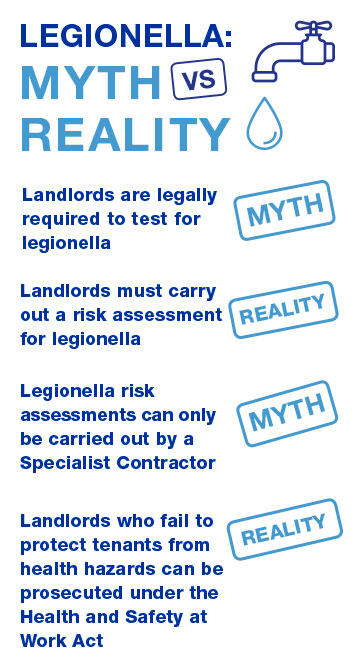Legionella Risks - 10 things you should know
Legionella is a risk that all property owners and managers should take seriously.
Legionella is a risk that all property owners and managers should take seriously.
This waterborne bacteria can lead to a range of illnesses, including the potentially fatal Legionnaire's Disease, which is an ongoing concern in the UK with 311 cases since 1st January 2019 through to the end of August.
Here, we answer 10 common concerns your property-owning customers may have about legionella, which you can easily share with them.
1. What causes legionella to spread?
Poor maintenance or poor management of a water system can create the conditions for legionella to thrive. Examples of poor maintenance include corroded, dirty water tanks in a warm loft space, or 'dead legs' in the pipework, where stagnant water has nowhere to go.
Poor management could be a situation where a flat has been left empty over a long, hot summer and the water has been left stagnant for too long.
2. Do I need to regularly test for legionella?
What is legionella?
Legionella is a bacteria usually found in harmlessly low quantities - in ponds, lakes and other water sources. However, it can multiply rapidly in complex water supply systems.
Legionella thrives on impurities such as rust and lime-scale, and in water temperatures between 20°C and 45°C. In rare circumstances, it can also spread in contaminated showers.
Legionella can lead to a number of diseases, including the potentially fatal lung infection Legionnaire's Disease, which is most common in the summer months.
No - there is no legal requirement for legionella testing other than in exceptional circumstances.
3. Do I need to carry out a risk assessment for legionella?
Yes - you are legally required to assess the risk of potential health and safety hazards in your properties, including legionella.
4. What should a risk assessment involve?
This largely depends on the nature of the water system - the more complicated the system, the more rigorous the assessment should be. The HSE states that a legionella risk assessment needs to identify whether:
- Water is stored or re-circulated as part of your system
- The water temperature in some or all parts of the system is between 20-45 °C
- There are sources of nutrients such as rust, sludge, scale and organic matters
- Conditions are present to encourage bacteria to multiply
- It is possible for water droplets to be produced and, if so, whether they could be dispersed over a wide area
Sources of risk can be identified by sight or by consulting the property's schematic diagram, which shows the layout of all water systems within the property. Certain types of property may require a more rigorous assessment - for example, student properties that are left unoccupied over the summer, or those with water tanks in a warm loft space.
5. Who should carry out a legionella risk assessment?
You can do it yourself, if you are confident that you have the necessary expertise. However, many landlords choose to employ a specialist contractor.
Regardless of who carries out the assessment, responsibility for ensuring it is completed to the required standards remains with whoever has been appointed as the competent person responsible for managing your health and safety risks.
6. Do I need to keep a record of my risk assessment, and how regularly should I review it?
You are not required by law to keep a written record, but a failure to do so could make it harder to defend any subsequent claim. Risk assessments should be reviewed whenever there is a change within a property that could affect the level of risk - for example, if there are alterations to the water system, if the property has been unoccupied for a long period, or if there are new tenants who may be more vulnerable to the effects of legionella, such as elderly people and those with pre-existing health conditions.
7. What should I do if I identify a risk?
Assess the risks appropriately, take any appropriate remedial action, for example, draining the water system while the property is unoccupied, removing redundant pipework, and testing the water to ensure the hot water runs above 60°C and the cold water runs below 20°C. Remember to keep a record of what you have done - this will support the claims team in their handling of a claim.
8. What should my tenants do?
Take simple, practical steps to reduce the risk of legionella, for example cleaning and descaling showerheads every six months. Their obligations should be clearly set out in tenancy agreements.
9. Can I be prosecuted if legionella is found in my property?
Under section 3 of the Health and Safety at Work Act, you could be prosecuted for failing to take reasonably practicable steps to avoid exposing your tenants to health and safety risks, including legionella. The maximum penalty for a breach of this section of the act is either an unlimited fine, up to two years in prison, or both.
10. What simple measures can I take to avoid exposure to Legionella?
- Flush out the system prior to letting the property
- Avoid debris getting into the system (e.g. ensure the cold water tanks, where fitted, have a tight fitting lid)
- Set control parameters (e.g. setting the temperature of the hot water cylinder (calorifier) to ensure water is stored at 60°C)
- Make sure any redundant pipework identified is removed
- Use instantaneous water heaters such as combi boilers and electric showers that do not store water
Where to go for further help
You and your customers can find out more about the myths and realities surrounding legionella on the HSE's website.
To find out more about how we can help your property-owning customers, speak to your usual Zurich contact.



